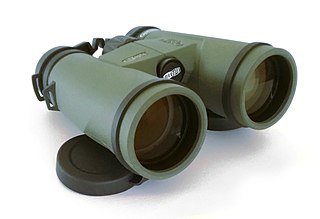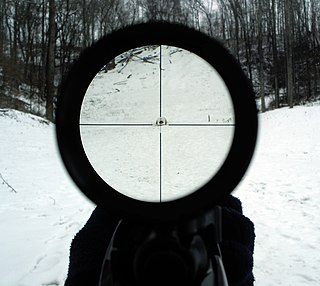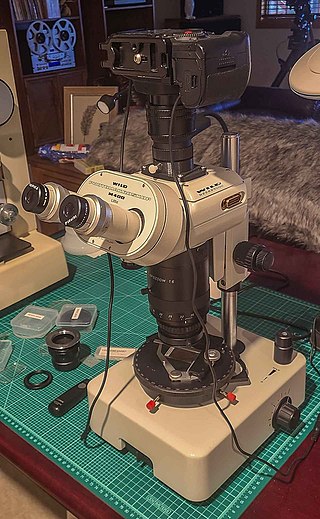
Binoculars or field glasses are two refracting telescopes mounted side-by-side and aligned to point in the same direction, allowing the viewer to use both eyes when viewing distant objects. Most binoculars are sized to be held using both hands, although sizes vary widely from opera glasses to large pedestal-mounted military models.

The optical microscope, also referred to as a light microscope, is a type of microscope that commonly uses visible light and a system of lenses to generate magnified images of small objects. Optical microscopes are the oldest design of microscope and were possibly invented in their present compound form in the 17th century. Basic optical microscopes can be very simple, although many complex designs aim to improve resolution and sample contrast.

A monocular is a compact refracting telescope used to magnify images of distant objects, typically using an optical prism to ensure an erect image, instead of using relay lenses like most telescopic sights. The volume and weight of a monocular are typically less than half of a pair of binoculars with similar optical properties, making it more portable and also less expensive. This is because binoculars are essentially a pair of monoculars packed together — one for each eye. As a result, monoculars only produce two-dimensional images, while binoculars can use two parallaxed images to produce binocular vision, which allows stereopsis and depth perception.

An optical telescope is a telescope that gathers and focuses light mainly from the visible part of the electromagnetic spectrum, to create a magnified image for direct visual inspection, to make a photograph, or to collect data through electronic image sensors.

In optical engineering, an objective is an optical element that gathers light from an object being observed and focuses the light rays from it to produce a real image of the object. Objectives can be a single lens or mirror, or combinations of several optical elements. They are used in microscopes, binoculars, telescopes, cameras, slide projectors, CD players and many other optical instruments. Objectives are also called object lenses, object glasses, or objective glasses.

Magnification is the process of enlarging the apparent size, not physical size, of something. This enlargement is quantified by a size ratio called optical magnification. When this number is less than one, it refers to a reduction in size, sometimes called de-magnification.

An eyepiece, or ocular lens, is a type of lens that is attached to a variety of optical devices such as telescopes and microscopes. It is named because it is usually the lens that is closest to the eye when someone looks through an optical device to observe an object or sample. The objective lens or mirror collects light from an object or sample and brings it to focus creating an image of the object. The eyepiece is placed near the focal point of the objective to magnify this image to the eyes. The amount of magnification depends on the focal length of the eyepiece.

A telescopic sight, commonly called a scope informally, is an optical sighting device based on a refracting telescope. It is equipped with some form of a referencing pattern – known as a reticle – mounted in a focally appropriate position in its optical system to provide an accurate point of aim. Telescopic sights are used with all types of systems that require magnification in addition to reliable visual aiming, as opposed to non-magnifying iron sights, reflector (reflex) sights, holographic sights or laser sights, and are most commonly found on long-barrel firearms, particularly rifles, usually via a scope mount. Similar devices are also found on other platforms such as Artillery, Tanks and even Aircraft. The optical components may be combined with optoelectronics to add night vision or smart device features.

In optics, the exit pupil is a virtual aperture in an optical system. Only rays which pass through this virtual aperture can exit the system. The exit pupil is the image of the aperture stop in the optics that follow it. In a telescope or compound microscope, this image is the image of the objective element(s) as produced by the eyepiece. The size and shape of this disc is crucial to the instrument's performance, because the observer's eye can see light only if it passes through the aperture. The term exit pupil is also sometimes used to refer to the diameter of the virtual aperture. Older literature on optics sometimes refers to the exit pupil as the Ramsden disc, named after English instrument-maker Jesse Ramsden.
The eye relief of an optical instrument is the distance from the last surface of an eyepiece within which the user's eye can obtain the full viewing angle. If a viewer's eye is outside this distance, a reduced field of view will be obtained. The calculation of eye relief is complex, though generally, the higher the magnification and the larger the intended field of view, the shorter the eye relief.
A parfocal lens is a lens that stays in focus when magnification/focal length is changed. There is inevitably some amount of focus error, but too small to be considered significant.

A star diagonal, erecting lens or diagonal mirror is an angled mirror or prism used in telescopes that allows viewing from a direction that is perpendicular to the usual eyepiece axis. It allows more convenient and comfortable viewing when the telescope is pointed at, or near the zenith. Also, the resulting image is right side up, but is reversed from left to right.

The PSO-1 is a 4×24 telescopic sight manufactured in Russia by the Novosibirsk instrument-making factory and issued with the Russian military Dragunov sniper rifle. It was introduced on 3 July 1963 together with the Dragunov sniper rifle.

Afocal photography, also called afocal imaging or afocal projection is a method of photography where the camera with its lens attached is mounted over the eyepiece of another image forming system such as an optical telescope or optical microscope, with the camera lens taking the place of the human eye.
In optics, a relay lens is a lens or a group of lenses that receives the image from the objective lens and relays it to the eyepiece. Relay lenses are found in refracting telescopes, endoscopes, and periscopes to optically manipulate the light path, extend the length of the whole optical system, and usually serve the purpose of inverting the image. They may be made of one or more conventional lenses or achromatic doublets, or a long cylindrical gradient-index of refraction lens.
In photography, a long-focus lens is a camera lens which has a focal length that is longer than the diagonal measure of the film or sensor that receives its image. It is used to make distant objects appear magnified with magnification increasing as longer focal length lenses are used. A long-focus lens is one of three basic photographic lens types classified by relative focal length, the other two being a normal lens and a wide-angle lens. As with other types of camera lenses, the focal length is usually expressed in a millimeter value written on the lens, for example: a 500 mm lens. The most common type of long-focus lens is the telephoto lens, which incorporate a special lens group known as a telephoto group to make the physical length of the lens shorter than the focal length.

A macroscope or photomacroscope in its camera-equipped version is a type of optical microscope developed and named by Swiss microscope manufacturers Wild Heerbrugg and later, after that company's merger with Leica in 1987, by Leica Microsystems of Germany, optimised for high quality macro photography and/or viewing using a single objective lens and light path, rather than stereoscopic viewing of specimens, at magnifications up to around x40. The Wild, subsequently Leica "macroscope" line was in production from approximately 1976–2003; it was succeeded by the Leica Z6 and Z16 offerings, which continued an equivalent functionality, but without the "macroscope" designation. The macroscope remains a useful, if somewhat specialised, instrument for examination of relevant specimens in various laboratories today.

A sight magnifier is an optical telescope that can be paired with a non-magnifying optical sight on a weapon to create a telescopic sight. They work with the parallel collimated reticle image produced by red dot sights and holographic weapon sights. They may synonymously be referred to as a red dot magnifier, reflex sight magnifier, holographic sight magnifier, or flip to side magnifiers.

A prism sight or prismatic sight, sometimes also called prism scope or prismatic scope, is a type telescopic sight which uses a reflective prism for its image-erecting system, instead of the series of relay lenses found in traditional telescopic sights. The use of prisms makes it possible to construct a shorter and lighter sight, or with an offset between the eyepiece and objective axes.



















